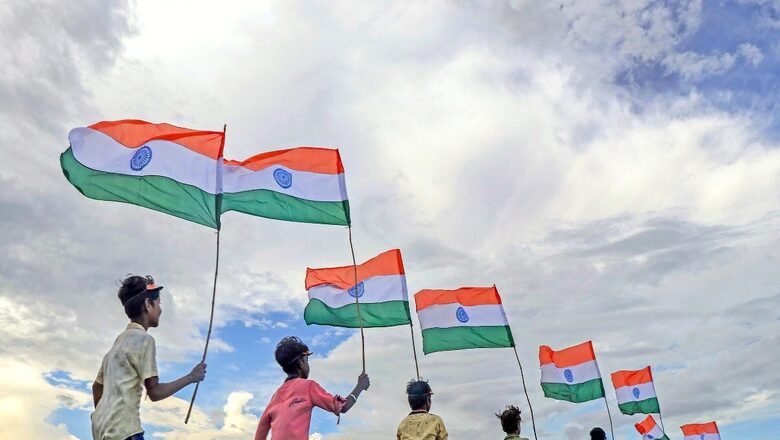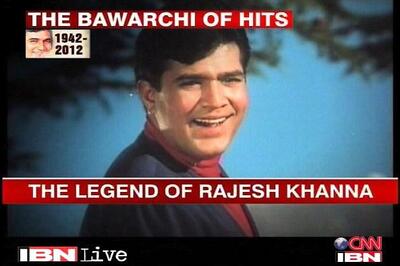
views
In the Mahabharata, amidst the stillness of the Kurukshetra battlefield, Lord Krishna guided Arjuna to a secluded corner, away from the tumult. There, Krishna dismounted Arjuna from his chariot and released the horses. In a dramatic moment, Lord Hanuman, who had been residing on the flag atop Arjuna’s chariot, vanished, leaving only a fluttering cloth behind. The chariot then erupted into flames, leaving only smouldering embers. Krishna revealed that the divine weapons wielded by Bheeshma, Drona, and Karna would have long ago obliterated the chariot were it not for Lord Hanuman’s sacred presence on the flag, which shielded it from destruction.
This ancient narrative underscores the profound symbolism of flags in Indian tradition — emblems of protection, unity, and divine guardianship. From Kartikeya’s Seval Kodi and Lord Ramachandra’s Surya flag in his quest to Lanka, to King Yudhishtira’s Golden Moon flag and the Patita Pavana Bana fluttering against the wind at Jagannath Temple in Puri, flags have always been central to our cultural heritage. The Nishan Sahib, representing both temporal and spiritual realms, holds a revered place in Sikh tradition.
Thus, it is fitting that this deep-rooted tradition continues as India strides into modernity. The flag stands not merely as a vision for our future but as a beacon of our rich and illustrious past, embodying the timeless values and grandeur of our civilisation.
In a world where chaos grips nations like Bangladesh and the threat of Balkanisation looms large, it is the enduring pride in our Tiranga that forges unity in India’s vast diversity. Amid global disarray, the Tiranga stands as a beacon of hope and cohesion, binding together our myriad cultures, languages, and identities. This unwavering reverence for our national flag galvanises us as one people, transcending differences and fostering a collective strength that distinguishes India as a pillar of stability and unity in turbulent times.
Prime Minister Narendra Modi aptly stated, “The Tiranga symbolises the spirit of freedom and national unity. Every Indian has an emotional connection with the Tricolour, and it inspires us to work harder to further national progress.”
As we mark the 77th anniversary of India’s Independence, the Har Ghar Tiranga campaign stands as a monumental testament to our nation’s unity, pride, and socio-economic advancement. The Har Ghar Tiranga initiative, launched in 2022 as part of Azadi Ka Amrit Mahotsav, seeks to bolster national unity and pride by urging every household to display the Tiranga. It encourages every Indian to hoist the tricolour beyond mere symbolism, embodying our collective aspirations and historical values.
While launching the initiative on July 22, 2022, PM Modi said, “Today, we remember the indomitable courage and efforts of all those who dreamt of a flag for an independent India when we were struggling against colonial rule. We reiterate our commitment to fulfil their vision and build the India of their dreams.”
The Essence of the Tricolour
Our national flag, the Tiranga, is a vibrant emblem of our nation’s spirit, with each of its colours carrying profound significance. The saffron stripe embodies courage and sacrifice, reflecting our enduring bravery and selflessness. The white band represents peace and truth, underscoring our commitment to harmony and integrity. Green signifies faith and chivalry, celebrating our dedication to justice and honour. The blue Ashoka Chakra stands as a testament to our rich heritage and cultural legacy.
These colours not only reflect the essence of our national values but also resonate deeply with our collective ethos and core principles of courage, truth, faith, and cultural pride. Designed by Pingali Venkayya and adopted on July 22, 1947, the Tricolour represents the struggle and triumphs of our freedom fighters and the principles upon which our democracy is built. The flags have been integral to our cultural heritage, symbolising glory, dharma, and unity across ages. The Tricolour, therefore, is a bridge connecting our illustrious past with our bright future.
Empowering Local Economies
The Har Ghar Tiranga campaign has sparked a renaissance for the Khadi industry, infusing new life into this traditional craft. By encouraging the display of the tricolour, there has been a notable surge in demand for Khadi flags, produced by small-scale artisans and vendors. This boost not only revitalises a time-honoured industry but also supports local economies and small vendors, fostering economic development and self-reliance.
As citizens embrace the campaign, they directly contribute to the sustainability of Khadi and the welfare of its artisans, creating a ripple effect of economic benefits across the country. On August 16, 2022, the Confederation of All India Traders (CAIT) reported that the Har Ghar Tiranga movement led to the sale of over 30 crore national flags, generating approximately Rs 500 crore in revenue. Let’s continue to support the vision of ‘Aatmanirbhar Bharat’ and ‘Vocal for Local’ this year as well, and with Modi 3.0 on the horizon, expectations are high for even greater success and impact in future campaigns.
The Har Ghar Tiranga initiative has not only ignited a wave of national pride but has also provided significant support to the Khadi industry, fostering its growth and visibility across the nation.
The Army’s Pride, National Unity and Integrity
In the last few years, we have witnessed certain vested groups and politicians in India working tirelessly to tarnish the country’s global reputation. These individuals have not only sought to undermine India’s robust democratic institutions on the international stage but have also actively fuelled caste divisions within the nation. Moreover, they have disseminated malicious misinformation and falsehoods about the Agniveer scheme with the deliberate intent of provoking our armed forces. This ‘Democracy is in Danger’ narrative represents a serious threat to the unity and integrity of our country.
For the men and women in uniform, the tricolour represents not just a symbol but a profound source of pride and motivation. The Har Ghar Tiranga campaign fosters a deep sense of unity and patriotism, reassuring our soldiers that every Indian stands shoulder to shoulder with them. The sight of the Tricolour proudly displayed across homes reaffirms their commitment to safeguarding our nation, knowing that their sacrifices are recognised and valued by every citizen. Our armed forces, in the wars of 1965, 1971, and 1999, fought with unwavering determination to ensure that the Tiranga remained aloft and unblemished. Their sacrifices and valour were driven by a resolute commitment to keep our flag flying high and proud.
In a world rife with geopolitical turmoil and regional conflicts, the Tricolour serves as a beacon of unity for India. The Har Ghar Tiranga campaign highlights the strength of our national identity and the power of collective pride to overcome divisions. As our neighbours grapple with unrest and fragmentation, the campaign underscores the significance of the Tricolour in fostering a sense of belonging and solidarity in a diverse and vibrant nation like India.
A Personal and Historical Connection
A flag is a symbol of a nation’s culture, heritage, and sovereignty. Over the past decade, Tiranga has not only flourished on the global stage but has also reinforced and showcased the strength of our culture and ethos. Har Ghar Tiranga initiative invites every Indian to forge a personal connection with the Tricolour, transforming it from a formal symbol into a cherished part of everyday life. By revisiting the story of our freedom struggle and honouring the legacy of leaders like Gandhiji, Netaji Subhas Chandra Bose, and Bhagat Singh, the Har Ghar Tiranga initiative seeks to bridge the gap between the past and present. It is an opportunity for younger generations to connect with the values and sacrifices that have shaped our nation, renewing their pride in our history and commitment to our future.
A Ground-Up Initiative
The Har Ghar Tiranga campaign exemplifies community participation and governmental facilitation. The amendment to the flag code has made the Tricolour more accessible, allowing every Indian to display it with pride. The government has ensured the availability of flags through post offices, e-commerce portals, and self-help groups, making it possible for every household to participate in this patriotic endeavour.
Echoes of Patriotism
In a world fraught with conflict and internal strife, PM Modi’s Har Ghar Tiranga initiative stands as a beacon of unity and national pride. Amidst India’s own internal challenges, this initiative has never been more pertinent. It serves not only as a symbol of national solidarity but also as a powerful reminder of our collective strength and resilience. In times when division threatens to overshadow unity, the Har Ghar Tiranga initiative is a clarion call to every citizen, reinforcing the values of patriotism and national cohesion.
Under the Tiranga, all are equal — no prince or peasant, no rich or poor. Here, privilege fades, and only duty, responsibility, and sacrifice remain. The Har Ghar Tiranga campaign is a heartfelt call to celebrate our unity, honour our past, and work together towards a brighter future.
In every fluttering Tricolour, we see not just a flag but a reflection of our shared dreams, resilience, and unyielding spirit. As the Tiranga graces homes across India, let it be a symbol of our collective pride and commitment to building a united and prosperous nation. Since 2014, the Tiranga has achieved a new stature, earning immense respect on the global stage. Let us honour this symbol of our pride and unity by embracing the Har Ghar Tiranga initiative with the respect and pride it deserves.
Dr. Naresh Bansal is Member of Parliament, Rajya Sabha, and National Co-Treasurer, BJP. Tuhin A. Sinha, National Spokesperson, BJP, and a popular author. Views expressed in the above piece are personal and solely that of the author. They do not necessarily reflect News18’s views.



















Comments
0 comment